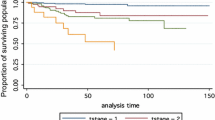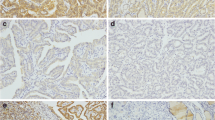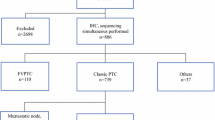Abstract
Papillary thyroid carcinomas (PTCs) are driven by a variety of molecular abnormalities including BRAF, RAS, ALK, RET, and NTRK alterations. PTCs driven by the BRAFV600E mutation, or tumours which demonstrate a similar gene expression profile to PTCs driven by this mutation, have been reported to demonstrate specific morphological features sometimes termed “BRAFV600E-like” atypia. BRAFV600E-like atypia is characterised by a well-developed papillary architecture, infiltrative growth, marked nuclear clearing, prominent intranuclear pseudoinclusions, abundant eosinophilic cytoplasm, and scattered psammoma bodies. We sought to investigate the sensitivity and specificity of these morphological features for the presence of BRAFV600E mutation in PTCs as determined by mutation specific immunohistochemistry. An unselected cohort of 495 PTCs was reviewed by a single pathologist and categorised into three groups: typical BRAFV600E-like atypia (145 cases, 29%), possible BRAFV600E-like atypia (166 cases, 33%) and little/no BRAFV600E-like atypia (184 cases, 37%). The specificity and sensitivity of typical BRAFV600E-like atypia for the BRAFV600E mutation was 97.2% and 44.3%, respectively. When typical and possible BRAFV600E-like atypia were analysed together, the specificity was 70.6% and the sensitivity was 81.7%. In the morphologically little/no BRAFV600E-like atypia group, 58 cases (31.5%) had a BRAFV600E mutation. We conclude that typical BRAFV600E-like atypia is highly specific for the presence of the BRAFV600E mutation; however, the absence of BRAFV600E-like atypia does not exclude this mutation.




Similar content being viewed by others
Availability of Data and Materials
Datasets are stored on a secure database (RedCap). Slides are stored in a locked cupboard in a locked room in the Cancer Diagnosis and Pathology Group laboratory.
References
Agrawal N, Akbani R, Aksoy BA, Ally A, Arachchi H, et al Integrated genomic characterization of papillary thyroid carcinoma. Cell 2014;159(3):676-90
WHO Classification of Tumours Editorial Board 2022, WHO Classification of Tumours of Endocrine Organs. Vol 10. 5th ed. Lyon, France: WHO/IARC Press
Baloch ZW, Asa SL, Barletta JA, Ghossein RA, Juhlin CC, Jung CK, LiVolsi VA, Papotti MG, Sobrinho-Simões M, Tallini G, Mete O. Overview of the 2022 WHO Classification of Thyroid Neoplasms. Endocrine pathology 2022;33(1):27-63.
Tallini G, Tuttle RM, Ghossein RA. The History of the Follicular Variant of Papillary Thyroid Carcinoma. J Clin Endocrinol Metab. 2017 Jan 1;102(1):15-22.
Virk RK, Theoharis CG, Prasad A, Chhieng D, Prasad ML. Morphology predicts BRAF (V600E) mutation in papillary thyroid carcinoma: an interobserver reproducibility study. Virchows Arch. 2014 Apr;464(4):435-42
Finkelstein A, Levy GH, Hui P, Prasad A, Virk R, Chhieng DC, Carling T, Roman SA, Sosa JA, Udelsman R, Theoharis CG, Prasad ML. Papillary thyroid carcinomas with and without BRAF V600E mutations are morphologically distinct. Histopathology. 2012 Jun;60(7):1052-9
Schwertheim S, Theurer S, Jastrow H, Herold T, Ting S, Westerwick D, Bertram S, Schaefer CM, Kälsch J, Baba HA, Schmid KW. New insights into intranuclear inclusions in thyroid carcinoma: Association with autophagy and with BRAFV600E mutation. PLoS One. 2019 Dec 16;14(12):e0226199.
Rossi ED, Martini M, Bizzarro T, Schmitt F, Longatto-Filho A, Larocca LM. Somatic mutations in solid tumors: a spectrum at the service of diagnostic armamentarium or an indecipherable puzzle? The morphological eyes looking for BRAF and somatic molecular detections on cyto-histological samples. Oncotarget. 2017 Jan 10;8(2):3746-3760
Virk RK, Van Dyke AL, Finkelstein A, Prasad A, Gibson J, Hui P, Theoharis CG, Carling T, Roman SA, Sosa JA, Udelsman R, Prasad ML. BRAFV600E mutation in papillary thyroid microcarcinoma: a genotype-phenotype correlation. Mod Pathol. 2013 Jan;26(1):62-70.
Bernstein J, Virk RK, Hui P, Prasad A, Westra WH, Tallini G, Adeniran AJ, Udelsman R, Sasaki CT, Roman SA, Sosa JA, Prasad ML. Tall cell variant of papillary thyroid microcarcinoma: clinicopathologic features with BRAF(V600E) mutational analysis. Thyroid. 2013 Dec;23(12):1525-31.
Pillai S, Gopalan V, Smith RA, Lam AK. Diffuse sclerosing variant of papillary thyroid carcinoma--an update of its clinicopathological features and molecular biology. Crit Rev Oncol Hematol. 2015 Apr;94(1):64-73
Dolezal JM, Trzcinska A, Liao CY, Kochanny S, Blair E, Agrawal N, Keutgen XM, Angelos P, Cipriani NA, Pearson AT. Deep learning prediction of BRAF-RAS gene expression signature identifies noninvasive follicular thyroid neoplasms with papillary-like nuclear features. Modern pathology : an official journal of the United States and Canadian Academy of Pathology, Inc 2021;34(5):862–74.
Jung CK, Bychkov A, Song DE, Kim JH, Zhu Y, Liu Z, Keelawat S, Lai CR, Hirokawa M, Kameyama K, Kakudo K. Molecular Correlates and Nuclear Features of Encapsulated Follicular-Patterned Thyroid Neoplasms. Endocrinology and metabolism (Seoul, Korea) 2021;36(1):123-33
Macerola E, Poma AM, Vignali P, Basolo A, Ugolini C, Torregrossa L, Santini F, Basolo F. Molecular Genetics of Follicular-Derived Thyroid Cancer. Cancers 2021;13(5):1139
Kakudo K. Different Threshold of Malignancy for RAS-like Thyroid Tumors Causes Significant Differences in Thyroid Nodule Practice. Cancers 2022;14(3):812.
Cho U, Mete O, Kim MH, Bae JS, Jung CK. Molecular correlates and rate of lymph node metastasis of non-invasive follicular thyroid neoplasm with papillary-like nuclear features and invasive follicular variant papillary thyroid carcinoma: the impact of rigid criteria to distinguish non-invasive follicular thyroid neoplasm with papillary-like nuclear features. Modern pathology : an official journal of the United States and Canadian Academy of Pathology, Inc 2017;30(6):810–25.
Gan X, Shen F, Deng X, Feng J, Lu J, Cai W, Peng L, Zheng W, Wang W, Huang P, Chen Z, Guo M, Xu B. Prognostic implications of the BRAF-V600E mutation in papillary thyroid carcinoma based on a new cut-off age stratification. Oncol Lett. 2020 Jan;19(1):631-640.
Xing M, Westra WH, Tufano RP, Cohen Y, Rosenbaum E, Rhoden KJ, Carson KA, Vasko V, Larin A, Tallini G, Tolaney S, Holt EH, Hui P, Umbricht CB, Basaria S, Ewertz M, Tufaro AP, Califano JA, Ringel MD, Zeiger MA, Sidransky D, Ladenson PW. BRAF mutation predicts a poorer clinical prognosis for papillary thyroid cancer. J Clin Endocrinol Metab. 2005 Dec;90(12):6373-9
Kim TY, Kim WB, Rhee YS, Song JY, Kim JM, Gong G, Lee S, Kim SY, Kim SC, Hong SJ, Shong YK. The BRAF mutation is useful for prediction of clinical recurrence in low-risk patients with conventional papillary thyroid carcinoma. Clin Endocrinol (Oxf). 2006 Sep;65(3):364-8.
Ahn D, Park JS, Sohn JH, Kim JH, Park SK, Seo AN, Park JY. BRAFV600E mutation does not serve as a prognostic factor in Korean patients with papillary thyroid carcinoma. Auris Nasus Larynx. 2012 Apr;39(2):198-203
Scheffel RS, de Cristo AP, Romitti M, Vargas CVF, Ceolin L, Zanella AB, Dora JM, Maia AL. The BRAFV600E mutation analysis and risk stratification in papillary thyroid carcinoma. Arch Endocrinol Metab. 2021 May 18;64(6):751-757
Fraser S, Go C, Aniss A, Sidhu S, Delbridge L, Learoyd D, Clifton-Bligh R, Tacon L, Tsang V, Robinson B, Gill AJ, Sywak M. BRAF(V600E) Mutation is Associated with Decreased Disease-Free Survival in Papillary Thyroid Cancer. World J Surg. 2016 Jul;40(7):1618-24.
Bullock M, O'Neill C, Chou A, Clarkson A, Dodds T, Toon C, Sywak M, Sidhu SB, Delbridge LW, Robinson BG, Learoyd DL, Capper D, von Deimling A, Clifton-Bligh RJ, Gill AJ. Utilization of a MAB for BRAF(V600E) detection in papillary thyroid carcinoma. Endocr Relat Cancer. 2012 Nov 9;19(6):779-84.
Choden S, Keelawat S, Jung CK, Bychkov A. An affordable immunohistochemical approach to estimate the prevalence of BRAFV600E in large cohort studies-establishing the baseline rate of BRAF mutation in an institutional series of papillary thyroid carcinoma from Thailand. Gland Surg. 2020 Oct;9(5):1867-1877.
Ilie MI, Lassalle S, Long-Mira E, Bonnetaud C, Bordone O, Lespinet V, Lamy A, Sabourin JC, Haudebourg J, Butori C, Guevara N, Peyrottes I, Sadoul JL, Bozec A, Santini J, Capper D, von Deimling A, Emile JF, Hofman V, Hofman P. Diagnostic value of immunohistochemistry for the detection of the BRAF(V600E) mutation in papillary thyroid carcinoma: comparative analysis with three DNA-based assays. Thyroid. 2014 May;24(5):858-66.
Parker KG, White MG, Cipriani NA. Comparison of Molecular Methods and BRAF Immunohistochemistry (VE1 Clone) for the Detection of BRAF V600E Mutation in Papillary Thyroid Carcinoma: A Meta-Analysis. Head Neck Pathol. 2020 Dec;14(4):1067-1079.
Shi X, Liu R, Basolo F, Giannini R, Shen X, Teng D, Guan H, Shan Z, Teng W, Musholt TJ, Al-Kuraya K, Fugazzola L, Colombo C, Kebebew E, Jarzab B, Czarniecka A, Bendlova B, Sykorova V, Sobrinho-Simões M, Soares P, Shong YK, Kim TY, Cheng S, Asa SL, Viola D, Elisei R, Yip L, Mian C, Vianello F, Wang Y, Zhao S, Oler G, Cerutti JM, Puxeddu E, Qu S, Wei Q, Xu H, O'Neill CJ, Sywak MS, Clifton-Bligh R, Lam AK, Riesco-Eizaguirre G, Santisteban P, Yu H, Tallini G, Holt EH, Vasko V, Xing M. Differential Clinicopathological Risk and Prognosis of Major Papillary Thyroid Cancer Variants. J Clin Endocrinol Metab. 2016 Jan;101(1):264-74.
Cheng S, Serra S, Mercado M, Ezzat S, Asa SL. A high-throughput proteomic approach provides distinct signatures for thyroid cancer behavior. Clinical Cancer Research : an Official Journal of the American Association for Cancer Research. 2011 Apr;17(8):2385-2394.
Tsang V, Gill A, Gild M, Lurie B, Blumer L, Siddall R, Clifton-Bligh R, Robinson B. Selpercatinib Treatment of RET-Mutated Thyroid Cancers Is Associated with Gastrointestinal Adverse Effects. The Journal of clinical endocrinology and metabolism 2022;107(9):e3824-e3829.
Angell TE. RAS-positive thyroid nodules. Curr Opin Endocrinol Diabetes Obes. 2017 Oct;24(5):372-376.
Chou A, Bullock S, Toon CW, Clarkson A, Sioson L, Farzin M, Cussigh C, Aniss A, O'Neill C, Watson N, Clifton-Bligh RJ, Learoyd DL, Robinson BG, Selinger CI, Delbridge LW, Sidhu SB, O'Toole SA, Sywak M, Gill AJ. A detailed clinicopathologic study of ALK-translocated papillary thyroid carcinoma. Am J Surg Pathol. 2015 May;39(5):652–9.
Nozaki Y, Yamamoto H, Iwasaki T, Sato M, Jiromaru R, Hongo T, Yasumatsu R, Oda Y. Clinicopathological features and immunohistochemical utility of NTRK-, ALK-, and ROS1-rearranged papillary thyroid carcinomas and anaplastic thyroid carcinomas. Hum Pathol. 2020 Dec;106:82-92.
Esce AR, Redemann JP, Sanchez AC, Olson GT, Hanson JA, Agarwal S, Boyd NH, Martin DR. Predicting nodal metastases in papillary thyroid carcinoma using artificial intelligence. Am J Surg. 2021 Nov;222(5):952-958.
Yoon J, Lee E, Koo JS, Yoon JH, Nam KH, Lee J, Jo YS, Moon HJ, Park VY, Kwak JY. Artificial intelligence to predict the BRAFV600E mutation in patients with thyroid cancer. PLoS One. 2020 Nov 25;15(11):e0242806.
Baloch ZW, LiVolsi VA. Pathologic diagnosis of papillary thyroid carcinoma: today and tomorrow. Expert Rev Mol Diagn. 2005 Jul;5(4):573-84.
Author information
Authors and Affiliations
Contributions
J.T. wrote the manuscript and prepared the figures. L.S. and A.C. prepared the laboratory slides. A.S. prepared and maintained the data. A.G. reviewed and edited the manuscript. All the other authors reviewed the manuscript.
Corresponding author
Ethics declarations
Ethical Approval
This study was approved by the Northern Sydney Local Health District Human Research Ethics Committee (protocols 1201-035 M and 1312-417 M).
Conflict of Interest
The authors declare no competing interests.
Additional information
Publisher's Note
Springer Nature remains neutral with regard to jurisdictional claims in published maps and institutional affiliations.
Rights and permissions
Springer Nature or its licensor (e.g. a society or other partner) holds exclusive rights to this article under a publishing agreement with the author(s) or other rightsholder(s); author self-archiving of the accepted manuscript version of this article is solely governed by the terms of such publishing agreement and applicable law.
About this article
Cite this article
Turchini, J., Sioson, L., Clarkson, A. et al. The Presence of Typical “BRAFV600E-Like” Atypia in Papillary Thyroid Carcinoma is Highly Specific for the Presence of the BRAFV600E Mutation. Endocr Pathol 34, 112–118 (2023). https://doi.org/10.1007/s12022-022-09747-9
Accepted:
Published:
Issue Date:
DOI: https://doi.org/10.1007/s12022-022-09747-9




